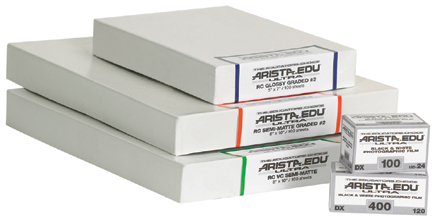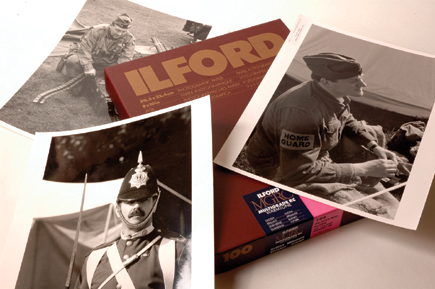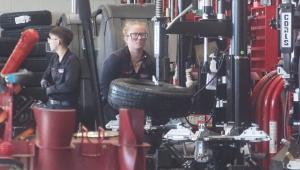This brand is certainly has good and with quality kind of products and I will gladly recommend this to my colleagues. - Scott Safadi
Photo Gear
Covering The Photo Beat; Black And White Papers
There are quite a few new photographic papers available this year, despite
many changes in the business. As with film and chemistry, the paper business
was affected by the "Ilford Factor."
From late August 2004, when Ilford went into receivership, to early February
2005, when a management buy-out succeeded, the future of Ilford was in some
doubt. Distributors therefore began to search for other papers they could sell.
Fortunately, loyal customers never stopped buying Ilford papers. In fact, although
there were supply problems, they were caused not by a slowdown in production,
but by panic buying on the part of Ilford loyalists! This loyalty was a great
help to the management buy-out team, because it showed their backers how solid
a customer base Ilford has. Indeed, Ilford's market share is now greater
than it was at the time they went into receivership.
 |
|
|
But that was only one factor. Forte also had financial difficulties but (as
with Ilford) these are now fully resolved. A consortium of Hungarian businessmen
have taken over the Forte works and part of the condition of sale was that they
continue to produce sensitized materials. This is doubly good news: not only
are Forte materials imported by OmegaSatter, but Forte also coats film and paper
for Bergger, whose premium products enjoy a deserved cult status.
Then there is the "Agfa Factor." In late May 2005, AgfaPhoto--which
was spun off from the old Agfa plant in November 2004--announced that they
had much the same problems as those from which Ilford had recently recovered.
As we went to press the situation was still not entirely clear.
Then again, a new entry to the paper market is Silver Tone from Event Cameras.
Event is a small company selling primarily to schools, but they will sell to
anyone, and they are really nice people.
 |
|
|
In the meantime, Luminos was sold to new management who decided to change
the emphasis of their business. This prompted Kentmere, the English company
which had hitherto coated papers for Luminos, to look elsewhere. They found
a willing distributor in Freestyle in Los Angeles.
As a result, you should now be able to find an exact equivalent to any of the
Luminos line-up under the Kentmere label, including such classics as Document
Art, and as a bonus there are also quite a few new Kentmere papers that Luminos
didn't bring in. Even more introductions are promised: we have already
received prototypes. If you haven't used Kentmere before, you have lots
of new papers to try. So get printing!
Freestyle have dropped their original Arista own-brand line and replaced it
with Arista II. Unlike some companies, they don't sell whatever is cheapest,
without changing the name. Rather, their Arista and EDU lines are top-quality
consistent products, coated and packed for them by leading manufacturers.
 |
|
|
Freestyle have also dropped Maco papers (from Cachet). They may still have
some stock, and Maco papers may still be available directly from Germany. Maco
has a list of importers on their website, www.mahn.net.
In the aftermath of the problems at Ilford and Forte, Paterson reassessed their
position. If either had gone under, Paterson was ready and willing to step in
with replacement papers and film. But Ilford came back strongly: as already
noted, their market share is now greater than it was before they went into receivership,
at around 2/3 of the total black and white market. Paterson has therefore decided
to pull out of sensitized materials altogether.
In June Kodak announced that it would be discontinuing all black and white photographic
paper by the end of 2005. They are still committed to film and chemicals though.
There should still be some Kodak paper stocks available. If you want to buy
a supply for future use, remember you can freeze paper to extend its life. Technical
details on discontinued papers are still available on the web.
Oriental papers are available from a number of sources. Check the ads in Shutterbug,
or contact Oriental Photo USA.
Agfa is still committed to the black and white market, though they have dropped
their graded papers to concentrate on multicontrast. Of course, their financial
restructuring may have an impact here as well: we are unlikely to see any new
Agfa black and white products in the near future. The most we can realistically
hope for in the coming year is a continuation of their excellent classical materials,
perhaps with periodical improvements and upgrades.
Tura AG ran into financial difficulties, and has pulled out of the US market
while they restructure.
Finally, the situation regarding other "private label" papers is
uncertain. Some companies jumped ship when Ilford ran into problems, and Ilford
has taken advantage of this to end all "private label" manufacture:
as they said, "There is no sense in competing with ourselves." Those
who moved to Agfa (or were originally with Agfa) may or may not have decided
to stay with the German company. They may take heart from Ilford's success,
and foresee the same for Agfa, or they may jump ship again. As "private
label" sellers usually prefer not to reveal their sources, the situation
may be fluid for a while yet.
 |
|
|
Paper Choice And Printing Technique
The most important thing, obviously, is the look of the print: warm tone, cool
tone, surface texture, tonality. The trouble is that there are so many papers
on the market, and their image color and tonality is so much affected by developer
choice, that you may need to try an awful lot of paper-developer combinations
before you find the one that is right for you.
You can however narrow down the choice of paper a great deal by thinking hard
about the effects you want, and about the prints you have seen that you like
best. Try to find out which papers were used for your favorite prints, and try
those.
Also, don't expect too much variation in image color. Sometimes, magazine
reports (and manufacturers' descriptions) can lead you to expect greater
differences than exist in real life, with blacks that are "rich and brown"
or "steely blue." It is true that "warm tone" and "cool
tone" look very different side by side, the former distinctly "chocolatey"
and the latter slightly bluish, but in isolation they both look like just, well,
black and white prints.
It is also worth knowing that "warm tone" papers usually respond
a lot faster and more dramatically to even mild toning. This is because the
silver grain size is smaller, so for a given image density there is a larger
surface area to react with the toner. For the same reason, warm tone papers
are usually slower: smaller crystal size means less speed, so Ilford Multigrade
Warmtone needs about twice the exposure of Cooltone.
Many people will tell you that at least half of all prints published or exhibited
receive some form of toning but as soon as you stop to think about it, you realize:
how do they know? Use toning only if you believe that it will make an already
excellent print better: don't use it in an attempt to save a failed image.
- Log in or register to post comments


































